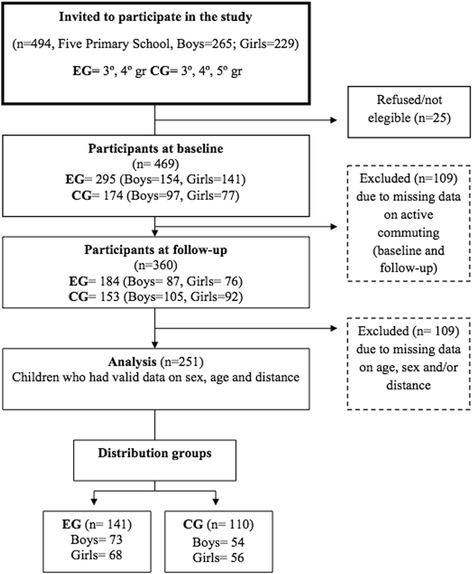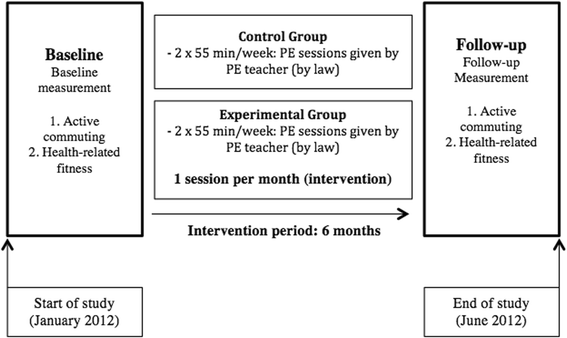Effects of a school-based intervention on active commuting to school and health-related fitness
- PMID: 28056914
- PMCID: PMC5216538
- DOI: 10.1186/s12889-016-3934-8
Effects of a school-based intervention on active commuting to school and health-related fitness
Abstract
Background: Active commuting to school has declined over time, and interventions are needed to reverse this trend. The main objective was to investigate the effects of a school-based intervention on active commuting to school and health-related fitness in school-age children of Southern Spain.
Methods: A total of 494 children aged 8 to 11 years were invited to participate in the study. The schools were non-randomly allocated (i.e., school level allocation) into the experimental group (EG) or the control group (CG). The EG received an intervention program for 6 months (a monthly activity) focused on increasing the level of active commuting to school and mainly targeting children's perceptions and attitudes. Active commuting to school and health-related fitness (i.e., cardiorespiratory fitness, muscular fitness and speed-agility), were measured at baseline and at the end of the intervention. Children with valid data on commuting to school at baseline and follow-up, sex, age and distance from home to school were included in the final analysis (n = 251). Data was analyzed through a factorial ANOVA and the Bonferroni post-hoc test.
Results: At follow up, the EG had higher rates of cycling to school than CG for boys only (p = 0.04), but not for walking to school for boys or girls. The EG avoided increases in the rates of passive commuting at follow up, which increased in the CG among girls for car (MD = 1.77; SE = 0.714; p = 0.010) and bus (MD = 1.77; SE = 0.714; p = 0.010) modes. Moreover, we observed significant interactions and main effects between independent variables (study group, sex and assessment time point) on health-related fitness (p < 0.05) over the 6-month period between groups, with higher values in the control group (mainly in boys).
Conclusion: A school-based intervention focused on increasing active commuting to school was associated with increases in rates of cycling to school among boys, but not for walking to school or health-related fitness. However, the school-based intervention avoided increases in rates of passive commuting in the experimental group, which were significantly increased in girls of the control group.
Keywords: Active transport; Cardiovascular fitness; Physical activity; Public health.
Figures
References
-
- Roman B, Serra-Majem L, Ribas-Barba L, Perez-Rodrigo C, Aranceta J. How many children and adolescents in Spain comply with the recommendations on physical activity? J Sports Med Phys Fit. 2008;48(3):380–387. - PubMed
MeSH terms
LinkOut - more resources
Full Text Sources
Other Literature Sources
Medical



